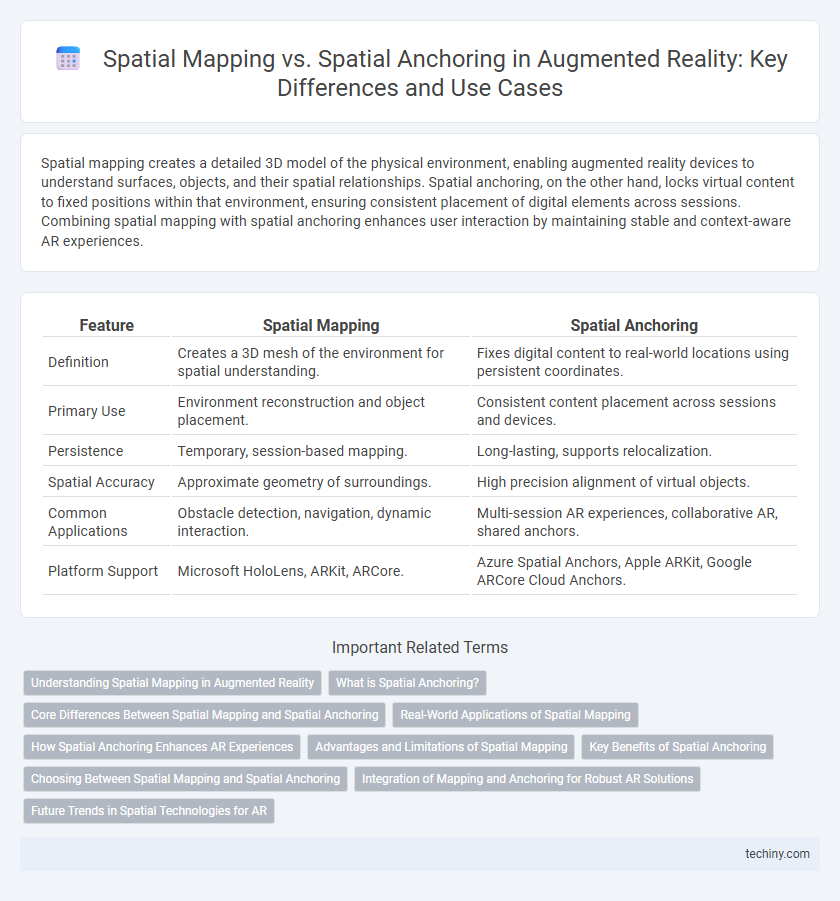Spatial mapping creates a detailed 3D model of the physical environment, enabling augmented reality devices to understand surfaces, objects, and their spatial relationships. Spatial anchoring, on the other hand, locks virtual content to fixed positions within that environment, ensuring consistent placement of digital elements across sessions. Combining spatial mapping with spatial anchoring enhances user interaction by maintaining stable and context-aware AR experiences.
Table of Comparison
| Feature | Spatial Mapping | Spatial Anchoring |
|---|---|---|
| Definition | Creates a 3D mesh of the environment for spatial understanding. | Fixes digital content to real-world locations using persistent coordinates. |
| Primary Use | Environment reconstruction and object placement. | Consistent content placement across sessions and devices. |
| Persistence | Temporary, session-based mapping. | Long-lasting, supports relocalization. |
| Spatial Accuracy | Approximate geometry of surroundings. | High precision alignment of virtual objects. |
| Common Applications | Obstacle detection, navigation, dynamic interaction. | Multi-session AR experiences, collaborative AR, shared anchors. |
| Platform Support | Microsoft HoloLens, ARKit, ARCore. | Azure Spatial Anchors, Apple ARKit, Google ARCore Cloud Anchors. |
Understanding Spatial Mapping in Augmented Reality
Spatial mapping in augmented reality involves creating a detailed 3D representation of the physical environment by scanning and analyzing surfaces, enabling virtual objects to interact accurately with real-world spaces. This process captures the geometry and spatial features of an area in real time, facilitating occlusion, collision detection, and realistic placement of digital content. Understanding spatial mapping is crucial for developing immersive AR experiences where virtual and physical worlds seamlessly blend.
What is Spatial Anchoring?
Spatial Anchoring is a critical technology in augmented reality that enables digital content to be precisely fixed to real-world locations, maintaining its position and orientation even as users move. Unlike spatial mapping, which scans and models the physical environment to detect surfaces and objects, spatial anchoring allows persistent placement and sharing of virtual objects across multiple devices and sessions. This capability is essential for applications requiring consistent interaction with digital elements anchored to specific physical points in space.
Core Differences Between Spatial Mapping and Spatial Anchoring
Spatial mapping captures and reconstructs the physical environment in 3D, enabling devices to understand surfaces and objects for interaction. Spatial anchoring, by contrast, attaches virtual content to fixed points in the real world, ensuring consistent placement across sessions and devices. The core difference lies in mapping creating an environmental mesh, while anchoring provides stable reference points for persistent spatial experiences.
Real-World Applications of Spatial Mapping
Spatial mapping creates detailed 3D models of physical environments, enabling AR devices to understand and interact with real-world spaces accurately. This technology is essential for applications in architecture, interior design, and industrial maintenance, where precise spatial awareness improves planning and execution. Its ability to capture spatial geometry in real time enhances navigation, object placement, and immersive AR experiences across various industries.
How Spatial Anchoring Enhances AR Experiences
Spatial anchoring enhances AR experiences by enabling digital content to maintain precise, stable positions within the physical environment, regardless of user movement or device orientation changes. Unlike spatial mapping, which simply scans and reconstructs the environment, spatial anchoring creates persistent reference points that allow AR objects to remain fixed and contextually relevant over time. This capability significantly improves interaction reliability and immersion, making AR applications more seamless and engaging.
Advantages and Limitations of Spatial Mapping
Spatial mapping excels in creating detailed 3D representations of physical environments, enabling accurate real-time interaction and object placement in augmented reality applications. Its advantages include the ability to dynamically update and capture complex surfaces, providing rich contextual awareness for immersive experiences. Limitations involve high computational demands, sensitivity to lighting conditions, and potential inaccuracies in large or featureless spaces that can affect spatial consistency.
Key Benefits of Spatial Anchoring
Spatial Anchoring offers precise and persistent alignment of virtual objects within real-world environments, enabling consistent user experiences across sessions and devices. This technology enhances collaborative AR applications by allowing multiple users to interact with shared spatial anchors, improving synchronization and accuracy. Key benefits include robust environmental tracking, improved stability of virtual content, and seamless integration into dynamic or large-scale physical spaces.
Choosing Between Spatial Mapping and Spatial Anchoring
Spatial mapping creates a detailed 3D model of the environment, enabling real-time interaction with physical spaces for AR applications, while spatial anchoring securely places virtual objects in fixed positions relative to the real world over time. Choosing between spatial mapping and spatial anchoring depends on the application's need for dynamic environmental understanding versus persistent object placement. Developers prioritize spatial mapping for dynamic scene reconstruction, whereas spatial anchoring is ideal for experiences requiring consistent alignment of virtual content across sessions and devices.
Integration of Mapping and Anchoring for Robust AR Solutions
Spatial mapping constructs a detailed 3D model of the environment, enabling precise understanding of physical spaces, while spatial anchoring locks virtual objects to fixed real-world locations for consistent alignment over time. Integrating spatial mapping with spatial anchoring enhances AR robustness by continuously updating environmental data and maintaining stable object positioning despite movement or changes. This synergy supports immersive and reliable AR experiences across diverse applications like navigation, maintenance, and interactive gaming.
Future Trends in Spatial Technologies for AR
Future trends in spatial technologies for augmented reality emphasize advancements in spatial mapping and spatial anchoring. Spatial mapping is evolving to deliver more precise and real-time 3D environment reconstructions using AI-powered sensors and edge computing, enabling dynamic adaptation to complex spaces. Spatial anchoring progresses through cloud-based persistence and collaborative frameworks, supporting multi-user experiences and seamless cross-device continuity in AR applications.
Spatial Mapping vs Spatial Anchoring Infographic

 techiny.com
techiny.com